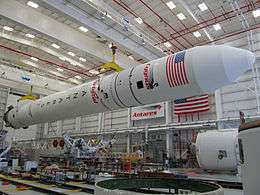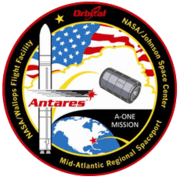Antares A-ONE
 The assembled Antares A-One rocket inside the Horizontal Integration Facility at Wallops | |
| Mission type | Technology demonstration |
|---|---|
| Operator | Orbital Sciences |
| COSPAR ID | 2013-016D |
| SATCAT № | 39145 |
| Mission duration | 603 seconds[1] |
| Spacecraft properties | |
| Spacecraft | Cygnus mass simulator |
| Manufacturer | Orbital Sciences |
| Launch mass | 3,800 kg (8,400 lb) |
| Dimensions | 5.061 × 2.896 m (199.25 × 114 in) |
| Start of mission | |
| Launch date | 21 April 2013, 21:00:02.2 UTC[2][3] |
| Rocket | Antares 110[4] |
| Launch site | MARS LP-0A |
| Contractor | Orbital Sciences |
| End of mission | |
| Disposal | Deorbited |
| Decay date | 10 May 2013 UTC |
| Orbital parameters | |
| Reference system | Geocentric |
| Regime | Low Earth |
| Perigee | 241 km (150 mi)[5] |
| Apogee | 260 km (162 mi)[5] |
| Inclination | 51.64°[5] |
| Epoch | 21 April 2013 |
 | |
Antares A-ONE was the maiden flight of Orbital Sciences' Antares rocket with a boilerplate payload, the Cygnus Mass Simulator, which was launched 21 April 2013.[6] It was launched from Pad 0A at the Mid-Atlantic Regional Spaceport (MARS) on Wallops Island, Virginia, USA.[5] The boilerplate payload simulates the mass of the Cygnus cargo spacecraft.[5] This dummy payload was sent into an orbit of "approximately 150 by 160 miles" (240 km x 260 km) with an inclination of 51.6 degrees.[6]
Four Spaceflight Inc. CubeSat nanosatellites were deployed from the dummy payload.[7]
This launch along with several other activities leading up to it, are paid milestones under NASA's Commercial Orbital Transportation Services program.[8]
Payloads
The primary payload was the Cygnus Mass Simulator (CMS). It had a height of 199.25 inches (5,061 mm), a diameter of 114 inches (2,900 mm) and a mass of 8,400 pounds (3,800 kg).[9] It was equipped with 22 accelerometers, 2 microphones, 12 digital thermometers, 24 thermocouples and 12 strain gages.[9]
The secondary payloads were four CubeSats that were deployed from the CMS.[9] Three of them were PhoneSats, 1U CubeSats built by NASA's Ames Research Center.[9] These were named Alexander, Graham and Bell, after the inventor of the telephone.[9] The purpose of these three satellites was to demonstrate the use of smartphones as avionics in CubeSats.[9] They each had a mass of 2.48 lb (1.124 kg) and were powered by lithium batteries.[9] The fourth nanosat was a 3U CubeSat, called Dove-1, built by Cosmogia Inc. It carried a "technology development Earth imagery experiment" using the Earth's magnetic field for attitude control.[9][10]
Mission timeline
- Lift off of the Antares rocket occurs two seconds after the first stage engines are ignited.
- The first stage engines shut off 228 seconds after lift-off.
- At 233 seconds, the second stage separates from the first.
- At 317 seconds, the payload fairing is jettisoned.
- At 326 seconds, the second stage's engine is ignited.
- At 481 seconds, the second stage is shut off.
- At 601 seconds, the Cygnus Mass Simulator separates.[5]
| Attempt | Planned | Result | Turnaround | Reason | Decision point | Weather go (%) | Notes |
|---|---|---|---|---|---|---|---|
| 1 | 17 Apr 2013, 5:00:00 pm | scrubbed | --- | technical | 17 Apr 2013, 4:44 pm (T-12 hold) | 60%[11] | Premature disconnect of upper stage umbilical cable during T-12 hold[12] |
| 2 | 20 Apr 2013, 6:10:00 pm | scrubbed | 3 days, 1 hour, 10 minutes | weather | 20 Apr 2013, 4:30 pm | 90% | [13] |
| 3 | 21 Apr 2013, 5:00:02 pm | success | 0 days, 22 hours, 50 minutes | 80% | First flight of Antares[14] |
Gallery
-

The Cygnus Mass Simulator
-

Antares rocket vertical at launch pad on 19 April 2013
-

Launch of the Antares rocket on 21 April 2013
-

Antares rocket rises into the blue sky on 21 April 2013
See also
References
- ↑ NASA/OSC Pre-launch press conference
- ↑ "Antares A-ONE Mission Coverage". Spaceflight 101. 21 April 2013. Retrieved 6 January 2016.
- ↑ Clark, Stephen (20 April 2013). "Antares A-One Mission Status Center". Spaceflight Now. Retrieved 20 April 2013.
- ↑ Bergin, Chris (22 February 2012). "Space industry giants Orbital upbeat ahead of Antares debut". NASA Spaceflight. Retrieved 29 March 2012.
- 1 2 3 4 5 6 "Antares A-ONE Test Launch Mission Overview" (PDF). Orbital Sciences. 2013. Retrieved 11 April 2013.
- 1 2 "Orbital Successfully Launches First Antares Rocket" (Press release). Orbital Sciences. 21 April 2013.
- ↑ Lindsey, Clark (21 March 2013). "Spaceflight Services installs four nanosats on Antares rocket". NewSpace Watch. Retrieved 21 March 2013. (subscription required (help)).
- ↑ "Space Act Agreement Amendment Seven between NASA and Orbital Sciences Corporation for COTS" (PDF). NASA. March 2012. Retrieved 16 March 2013.
- 1 2 3 4 5 6 7 8 "Antares Test Launch "A-ONE Mission" Overview Briefing" (PDF). Orbital Sciences. 17 April 2013. Retrieved 18 April 2013.
- ↑ Mason, James; Safyan, Michael (1 January 2012). "Cosmogia Dove - 1 Orbital Debris Assessment Report". Cosmogia. Retrieved 18 April 2013.
- ↑ Orbital Sciences (17 April 2013). "Still marching toward the first launch...". Twitter.
- ↑ Orbital Sciences (17 April 2013). "The umbilical was a data cable connected...". Twitter.
- ↑ Orbital Sciences (20 April 2013), "#Antares launch attempt scrubbed...", Twitter
- ↑ Harwood, William (21 April 2013). "Antares rocket climbs into space on maiden flight". CBS News.
External links
| Wikimedia Commons has media related to Antares A-ONE. |
- Antares Test Launch “A-ONE Mission” Overview Briefing
- Mission Overview
- NASA mission page
- Video of Pre-Flight Press Conference - Part 1 - YouTube (NASATelevision)
- Video of Pre-Flight Press Conference - Part 2 - YouTube (NASATelevision)
- Video of Antares A-One rocket being rolled out to launch pad - YouTube (NASATelevision)
- Video of the launch of the Antares A-One rocket - YouTube (NASATelevision)